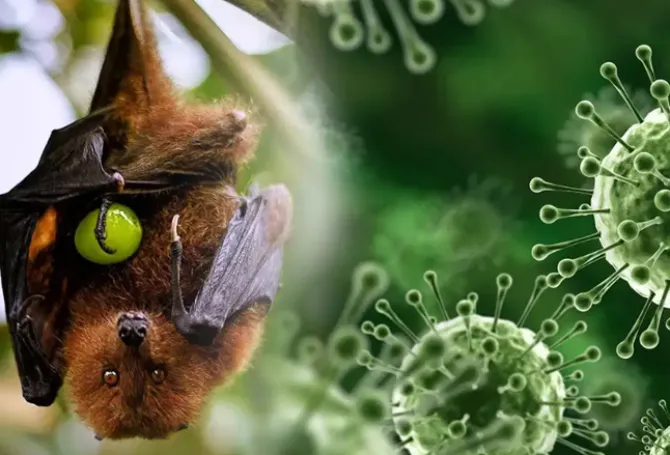
Kerala, a tiny state located at the Southern tip of India, is going through its fourth Nipah virus outbreak in five years. Although reported intermittently elsewhere, for over two decades, Kerala's first known encounter with Nipah was in 2018, witnessing a 91 percent mortality rate with 21 out of 23 patients succumbing. Earlier this year, a mortality rate of 73 percent was observed during outbreaks in Bangladesh. While the mortality rate is among the highest for any known viral disease, what offers a degree of relief is the fact that this virus does not spread efficiently from person to person. Therefore, all outbreaks have been self-limiting. The two most recent outbreaks in Bangladesh affected five and six people respectively. The previous two outbreaks in Kerala affected only one individual each. In the present outbreak, two people have died and four individuals who apparently contracted the virus from the index patient are hospitalised.
While the mortality rate is among the highest for any known viral disease, what offers a degree of relief is the fact that this virus does not spread efficiently from person to person.
Not an easy diagnosis to make
The initial symptoms of Nipah virus infection in humans are not different from common viral fevers. This makes it extremely difficult to diagnose the first case. As the disease advances, the initial symptoms of fever, headache and muscle pain may either progress to pneumonia or lead to neurological manifestations, including disorientation, speech impairment, mobility impairment and seizures. In the absence of effective antivirals and vaccines, early supportive care plays a crucial role in mitigating the overall impact. The Nipah virus belongs to Paramyxoviridae, a family which includes measles and mumps viruses. It circulates freely among fruit bats, without causing apparent disease or death. However, when the virus jumps to human beings, it presents a different picture.
During Nipah outbreaks in Malaysia, the transmission was initially from bats to pigs, and later from pigs to humans.
The virus has also been isolated from other animals such as goats, dogs, cats, and pigs. During Nipah outbreaks in Malaysia, the transmission was initially from bats to pigs, and later from pigs to humans. In contrast, the outbreaks in Bangladesh and India are believed to have occurred directly from bats to humans for the index case, followed by clusters from human-to-human transmission.
Why Kerala again?
Being close to the Western Ghats makes a densely populated state like Kerala a potential hotspot for zoonotic virus outbreaks. Bats have always been in close proximity to human habitation because of the presence of fruit trees in such areas. The ability of the healthcare system to pick up early signals of such outbreaks is another factor. Unless the disease is specifically suspected and investigated, such outbreaks would be missed.
The mystery surrounding Nipah outbreaks
In India, where multiple outbreaks have already occurred, the precise mechanism by which the index patient gets infected is still unknown. In other words, the mechanism by which the virus jumped from bats to humans has not been delineated, although hypotheses such as consumption of fruit that was half-eaten by bats are commonplace. Outbreak investigations from Bangladesh report consumption of raw data palm sap as the mechanism of spillover. Using infrared cameras, researchers witnessed bats visiting the date palm sap tapping apparatus located on trees at night, contaminating the nectar collected in the pot. However, it must be noted that date palm sap is regularly consumed by thousands of people in rural Bangladesh, and Nipah outbreaks occur only in a handful.
The mechanism by which the virus jumped from bats to humans has not been delineated, although hypotheses such as consumption of fruit that was half-eaten by bats are commonplace.
Why the difficulty in identifying the precise mechanism?
There is a paradox that prevents this link from being unlocked. The index patient who suffers from Nipah is almost invariably dead or incapacitated by the time an investigation is launched. This is because Nipah is diagnosed only after the disease turns severe in the index patient, and the suspicion is often triggered after it is seen to be spreading amongst close contacts. By the time it is finally confirmed, the index patient might have succumbed. In such a setting, taking a detailed, granular history about how exactly this individual might have picked up the virus becomes logistically difficult. In the published case report from 2018, Bhargavan et al describe the index patient to be an animal lover who might have had contact with a bat pup or consumed bat-bitten fruit. Furthermore, since index cases are relatively few, establishing a clear cause-and-effect relationship is challenging, as correlation does not necessarily imply causation. The virus is present in the saliva, reproductive fluids, urine, and excreta of the bat. During the breeding season, such material can easily be found on trees and ground, raising the possibility of an initial spillover into a yet unidentified intermediate host. Until this mystery is unravelled, it will be impossible to make more precise recommendations that could help prevent another outbreak.
Nipah outbreaks could have been missed
Bats carrying the Nipah virus have been identified in several states in India. It is quite possible that outbreaks have occurred in an isolated fashion in other parts of India too, but escaped detection because they were self-limiting and was not suspected in the first place.
Since index cases are relatively few, establishing a clear cause-and-effect relationship is challenging, as correlation does not necessarily imply causation.
Infrequently discussed is the socioeconomic consequence of such outbreaks. During the 2018 outbreak, there was mass panic in Kerala, leading to a loss of revenue, a steep fall in fruit sales and even a ban on fruit imports imposed by Middle Eastern nations. The resulting unemployment, loss of wages, public anxiety, and social stigmatisation are complications that merit greater consideration while planning public health strategies.
Nipah vs COVID-19
With the latest Nipah outbreak occurring in the shadow of the COVID-19 pandemic, public perception has involved a certain amount of panic. Many individuals have lost relatives and friends to COVID-19 in the past three years, and therefore it is understandable to slip into a catastrophic thinking when they hear about a new virus outbreak. During the first year of the pandemic, when there was no natural immunity in the population, the SARS-CoV-2 virus had an R-0 of 2 to 3. This means that if one person contracted COVID-19, on average, that person could transmit it to three others, and those three could then pass it on to nine, and so on.
For the Nipah Virus, R-0 is only 0.4, which means that if 10 people got the virus, they could only pass it on to four people and these four individuals could infect a maximum of two people and so on.
In contrast, for the Nipah Virus, R-0 is only 0.4, which means that if 10 people got the virus, they could only pass it on to four people and these four individuals could infect a maximum of two people and so on. In other words, when the R-0 is below one, the outbreak will inevitably die down.
If outbreaks are self-limiting, is the contact tracing effort justified?
Nipah is a contagious disease with a high mortality risk attracting global interest and must be treated with due diligence. If the spread can be halted even one step earlier, it directly translates to lives saved. That being said, contact tracing requires customisation based on the likelihood of transmission. The index patient is most contagious while severely symptomatic, for instance, while coughing or vomiting, and such patients are typically admitted to the hospital. It is worth noting that patients who are severely ill are not physically able to visit public places where they can spread the virus to several others. Thus, a caregiver exposed to a patient's bodily secretions faces a higher risk, as opposed to a random person who shared a public place with the patient before the illness set in.
Nipah is a contagious disease with a high mortality risk attracting global interest and must be treated with due diligence.
Too much of a good thing?
Excessive contact tracing beyond reasonable clinical suspicion can result in unwarranted anxiety, economic disruption, and wastage of resources. Some measures taken by neighbouring states such as screening of interstate travellers are of no preventive value and lack epidemiological rationale. Greater emphasis should be placed on promoting disease awareness among healthcare personnel and improving surveillance, reporting, and diagnostic facilities. There is no need to induce panic among people who are located far away from the point of the outbreak because unlike COVID, Nipah has not spread far and wide in 25 years of known history. It is, however, listed on the WHO’s list of viruses with pandemic potential along with Ebola, Lassa fever, Zika, and a few others.
Dr Rajeev Jayadevan is the former president of the Cochin Chapter of the Indian Medical Association and was a member of the National Task Force IMA for Coronavirus Epidemic
The views expressed above belong to the author(s). ORF research and analyses now available on Telegram! Click here to access our curated content — blogs, longforms and interviews.




 PREV
PREV


